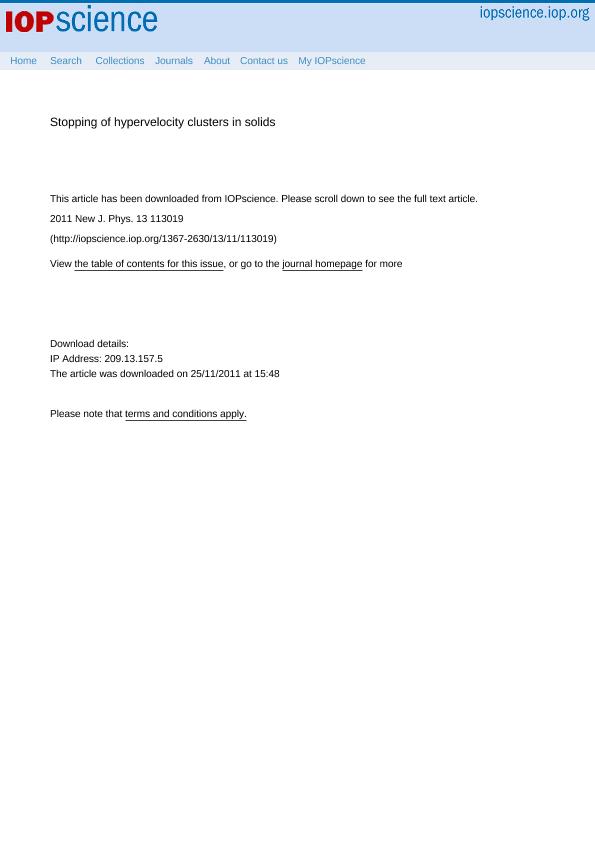Mostrar el registro sencillo del ítem
dc.contributor.author
Anders, Christian
dc.contributor.author
Bringa, Eduardo Marcial

dc.contributor.author
Ziegenhain, Gerolf
dc.contributor.author
Urbassek, Herbert M.
dc.date.available
2017-06-08T19:15:48Z
dc.date.issued
2011-11
dc.identifier.citation
Anders, Christian; Bringa, Eduardo Marcial; Ziegenhain, Gerolf; Urbassek, Herbert M.; Stopping of hypervelocity clusters in solids; Iop Publishing; New Journal Of Physics; 13; 11-2011; 13019-13036
dc.identifier.issn
1367-2630
dc.identifier.uri
http://hdl.handle.net/11336/17798
dc.description.abstract
Using molecular-dynamics simulations, we study the processes underlying the stopping of energetic clusters upon impact in matter. We investigate self-bombardment of both a metallic (Cu) and a van-der-Waals bonded (frozen Ar) target. Clusters with sizes up to N = 104 atoms and with energies per atom of E/N = 0.1–1600 eV atom−1 were studied. We find that the stopping force exerted on a cluster follows an N 2/3 -dependence with cluster size N; thus large clusters experience less stopping than equi-velocity atoms. In the course of being stopped, the cluster is strongly deformed and attains a roughly pancake shape. Due to the cluster inertia, maximum deformation occurs later than the maximum stopping force. The time scale of projectile stopping is set by t0, the time the cluster needs to cover its own diameter before impacting the target; it thus depends on both cluster size and velocity. The time when the cluster experiences its maximum stopping force is around (0.7–0.8)t0. We find that the cluster is deformed with huge strain rates of around 1/2t0; this amounts to 1011–1013 s −1 for the cases studied here.
dc.format
application/pdf
dc.language.iso
eng
dc.publisher
Iop Publishing

dc.rights
info:eu-repo/semantics/openAccess
dc.rights.uri
https://creativecommons.org/licenses/by-nc-nd/2.5/ar/
dc.subject
Condensed Matter
dc.subject
Hypervelocity Clusters
dc.subject
Impacts
dc.subject.classification
Astronomía

dc.subject.classification
Ciencias Físicas

dc.subject.classification
CIENCIAS NATURALES Y EXACTAS

dc.title
Stopping of hypervelocity clusters in solids
dc.type
info:eu-repo/semantics/article
dc.type
info:ar-repo/semantics/artículo
dc.type
info:eu-repo/semantics/publishedVersion
dc.date.updated
2017-04-07T13:40:38Z
dc.journal.volume
13
dc.journal.pagination
13019-13036
dc.journal.pais
Reino Unido

dc.journal.ciudad
Londres
dc.description.fil
Fil: Anders, Christian. University Kaiserslautern. Fachbereich Physik und Forschungszentrum OPTIMAS; Alemania
dc.description.fil
Fil: Bringa, Eduardo Marcial. Universidad Nacional de Cuyo. Facultad de Ciencias Exactas y Naturales; Argentina. Consejo Nacional de Investigaciones Científicas y Técnicas. Centro Científico Tecnológico Conicet - Mendoza; Argentina
dc.description.fil
Fil: Ziegenhain, Gerolf. University Kaiserslautern. Fachbereich Physik und Forschungszentrum OPTIMAS; Alemania
dc.description.fil
Fil: Urbassek, Herbert M.. University Kaiserslautern. Fachbereich Physik und Forschungszentrum OPTIMAS; Alemania
dc.journal.title
New Journal Of Physics

dc.relation.alternativeid
info:eu-repo/semantics/altIdentifier/doi/http://dx.doi.org/10.1088/1367-2630/13/11/113019
dc.relation.alternativeid
info:eu-repo/semantics/altIdentifier/url/http://iopscience.iop.org/article/10.1088/1367-2630/13/11/113019/meta
Archivos asociados
